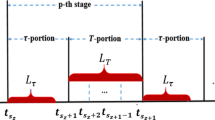Abstract
This study presents a practical active noise control (ANC) algorithm with robust stability for reducing the powertrain noise or vibration inside a car. It is important to ensure that a practical ANC system for a car is robustly stable to variations or uncertainties in the actual plant. After investigating the robust stability condition of the ANC algorithm, a robust plant model is designed by considering the multiplicative plant uncertainties within given bounds such as closing or opening door windows. The ANC algorithm was implemented in a dSPACE DS1401 as a control platform, and an error microphone and a subwoofer as a secondary source were positioned at the driver’s left ear and the trunk of the experimental car, respectively. The engine rpm information received from the controller area network of the car was used for the generation of relevant reference signals. The real-time control experiments were carried out against the plant perturbation when the engine was either idling or sweeping in the neutral mode. The results showed that the robust control algorithm can suppress the noise whether the actual plant was nominal or perturbed with the stability over the rpm.










Similar content being viewed by others
References
Berkhoff AP (2012) A technique for improved stability of adaptive feedforward controllers without detailed uncertainty measurements. Smart Mater Struct 21(6):11, Article ID 064003
Boucher CC, Elliott SJ, Nelson PA (1991) Effect of errors in the plant model on the performance of algorithms for adaptive feedforward control. Proc Inst Electr Eng F 138(4):313–319
Elliott SJ (2001) Signal processing for active control. Academic Press, New York
Elliott SJ, Stothers IM, Nelson PA, McDonald AM, Quinn DC, Saunders T (1988) The active control of engine noise inside cars. In: INTER-NOISE and NOISE-CON Congress and Conference Proceedings (InterNoise ’88), vol 1998, no 3, pp 987–990
Fraanje PR, Elliott SJ, Verhaegen M (2007a) Robustness of the filtered-X LMS algorithm—part I: necessary conditions for convergence and the asymptotic pseudospectrum of toeplitz matrices. IEEE Trans Signal Process 55(8):4029–4037
Fraanje PR, Elliott SJ, Verhaegen M (2007b) Robustness of the filtered-X LMS algorithm—part II: robustness enhancement by minimal regularization for norm bounded uncertainty. IEEE Trans Signal Process 55(8):4038–4047
Kuo SM, Morgan DR (1996) Active noise control systems: algorithms and DSP implementations. Wiley, New York
Kuo SM, Morgan DR (1999) Active noise control: a tutorial review. Proc IEEE 97(6):943–973
Lee Y-S, Choi Y, Kim J (2016) Length variation effect of the impulse response model of a secondary path in embedded control. J Sens 2016:7, Article ID 8270121
Morari M, Zafiriou E (1989) Robust process control. Prentice-Hall, Englewood Cliffs
Ren W, Kumar PR (1989) Adaptive active noise control: structures, algorithms and convergence analysis. In: Proceedings of the engineering for environmental noise control (INTER-NOISE’89), pp 435–440
Rupp M, Sayed AH (1998) Robust FxLMS algorithms with improved convergence performance. IEEE Trans Signal Process 6(1):78–85
Thomas JK, Lovstedt SP, Blotter JD, Sommerfeldt SD (2008) Eigenvalue equalization filtered-x algorithm for the multichannel active noise control of stationary and nonstationary signals. J Acoust Soc Am 123(6):4238–4249
Wang AK, Ren W (1999) Convergence analysis of the multi-variable filtered-x LMS algorithm with application to active noise control. IEEE Trans Signal Process 47(4):1166–1169
Acknowledgements
This work was supported by the Incheon National University Research Grant in 2014.
Author information
Authors and Affiliations
Corresponding author
Ethics declarations
Conflict of interest
All Authors declares that they have no conflict of interest.
Ethical approval
This article does not contain any studies with human participants or animals performed by any of the authors.
Additional information
Communicated by M. Anisetti.
Rights and permissions
About this article
Cite this article
Kim, J., Lee, M. & Lee, YS. Real-time implementation of a robust active control algorithm for narrowband signals suppression. Soft Comput 22, 1545–1554 (2018). https://doi.org/10.1007/s00500-017-2943-6
Published:
Issue Date:
DOI: https://doi.org/10.1007/s00500-017-2943-6




